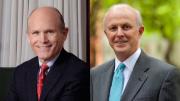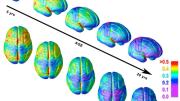The University’s fiscal year 2015, concluded last June 30 and detailed in the annual financial report released in late October, mirrors the outcome of the prior year: Harvard again operated in the black, following a couple of years of small deficits. In their introductory letter, Harvard’s senior financial-management team—Thomas J. Hollister, vice president for finance and chief financial officer, and Corporation member Paul J. Finnegan, who is treasurer—wrote, “[T]he results of this past fiscal year follow a recent trend of modest, but continued improvement in the University’s overall financial health.” Among the highlights:
• Revenue increased 3.1 percent, to $4.53 billion from $4.39 billion (figures are rounded). Major contributors were the endowment distribution for operations (up $54.8 million, or 3.6 percent); tuition and other income from students (up $52.3 million, or 6.0 percent); and gifts for current use (up $16.5 million, or 3.9 percent). Total support for sponsored research edged up by $5.9 million, to $805.8 million—but only because corporate, foundation, and international underwriting rose by more than 10 percent, while federal direct funding decreased by nearly $15 million.
• Expenses increased 2.2 percent, to $4.46 billion from $4.37 billion. Salaries and wages were 5.2 percent higher, reflecting a larger workforce and merit increases in compensation. Employee benefits were reported to have decreased 4.7 percent—but adjusting for a one-time, $45.9-million pension-related charge incurred in fiscal 2014, benefits costs increased somewhat less than 5 percent, to nearly $500 million. Space and occupancy costs soared more than 9 percent, but were more than offset by a $40-million reduction in other expenses; both reflect one-time items.
• An operating surplus was the result: Harvard finished the year in the black to the tune of $62.5 million. As originally reported, fiscal 2014 yielded a surplus of just $2.7 million; that has been restated to a surplus of $22 million. If the pension-related charge were excluded, fiscal 2014 would have closed with a surplus of $68 million—slightly ahead of the fiscal 2015 gain.
More broadly, income from students (typically the schools’ largest source of unrestricted funding) has been growing smartly: up 7.3 percent in fiscal 2014 after deducting scholarships applied to tuition and fees, and a further 6 percent in fiscal 2015, to $930 million. As recently as fiscal 2013, sponsored-research funding was Harvard’s second-largest source of operating revenue (after the endowment distribution, and ahead of student income); now, with research funding stagnant and tuition and fees growing, their relative standing has been reversed, with tuition and fees progressively outstripping sponsored support.
The 7.4 percent rise in continuing-education and executive-programs tuition (to $346 million) has to please Hollister and Finnegan, who repeat a theme from recent financial reports: the focus on “exploring alternative revenue sources.” Tiny now, but of prospective importance as one of those “alternative” revenue sources, is income from general-interest online courses; in a recent white paper on HarvardX and other teaching initiatives (see page 24), Provost Alan Garber listed “economic sustainability” as the first of three priorities deserving “special attention.”
The after-financial-aid tuition and fee figure is what matters: the cash available to deans once they have met student needs. The fiscal 2014 and 2015 results are suggestive. Scholarships applied to student income (reductions in term bills, for instance) rose just 3.0 percent, to $384 million—below the 3.7 percent growth in fiscal 2014. And other scholarships and awards paid directly to students increased just 4.6 percent. Even with robust growth in continuing and executive education (which affects the tuition mix), demand for financial aid in degree programs appears to be easing—a proxy for the improving economy.
Data from the Faculty of Arts and Sciences (FAS) confirm the trend: its undergraduate-aid spending rose from $164.2 million in fiscal 2012 to $165.6 million the next year, and $170.2 million in fiscal 2014—before decreasing, minimally, to $170.1 million in the most recent year. That reflects a sharp change from the period beginning in 2007, when financial aid was expanded significantly, and then demand soared as the recession crimped family incomes.
In the meantime, University fundraisers continue to pursue gifts for aid: to secure the programs put in place during the past decade; to cope with families’ rising education costs; and to enable deans to apply more of those unrestricted net tuition receipts to other academic needs. President Drew Faust focused on The Harvard Campaign (see updates, page 26) in her letter in the financial report; she noted that some $686 million had been secured for financial aid across the University—about halfway toward the goal for scholarships.
The message to eager faculties would appear to be twofold: be patient and be clever.
The endowment remains at the center of Harvard’s finances, again contributing 35 percent of operating revenues: $1.59 billion in fiscal 2015, and $1.54 billion in fiscal 2014. The Corporation is being careful with endowment funds: the operating distribution equaled just 4.6 percent of the endowment’s value at the beginning of the fiscal year, down from 4.9 percent in the prior year. As previously reported, Harvard Management Company (HMC) realized a 5.8 percent return on endowment assets, net of all expenses, in fiscal 2015 (see “Endowment Gain—and Gaps,” November-December 2015, page 22, and “Overhauling the Endowment,” below). For fiscal 2016, the planning guidance to deans envisions a 4 percent increase in the operating distribution, plus a “bonus” distribution of 2 percent for one-time expenses (ensuring that those extra activities will not be built into schools’ permanent expense base, and perhaps reflecting HMC’s most recent results).
Not for nothing have higher-education administrators and science professors been raising alarms about the nation’s research budget. As noted, federal direct sponsorship for research continued to decrease. Other sources of direct research support increased by $18 million; but indirect-cost recoveries associated with such nonfederal grants are a small fraction of those accompanying federal sponsorship, placing a burden on the institution to maintain the research enterprise (see the discussion in “Faculty Figures,”).
Even with the campaign’s success, a conservative course toward growth appears to be in place, given persistent, large operating deficits in FAS and Harvard Medical School. Still, the campaign is having its intended effect. Gifts for current use, generated during the current fund drive, yielded 10 percent of Harvard’s fiscal 2015 revenues. Pledges receivable, a good gauge of what is on tap, surged to $2.25 billion at year-end, up from $1.59 billion at the end of fiscal 2014.
The pipeline is filling robustly—but there is a lag, sometimes considerable, between donors’ pledges and the delivery of the funds to Harvard. FAS, where current-use gifts rose 21 percent during fiscal 2015, explicitly noted the importance of “a new hybrid gift policy”—encouraging donors to provide a share of certain major gifts in the form of current-use funds. The message to eager faculties would appear to be twofold: be patient—the fruits from the campaign are coming; and be clever, so that donors who are committed to investing in Harvard may be encouraged to do so more quickly.









